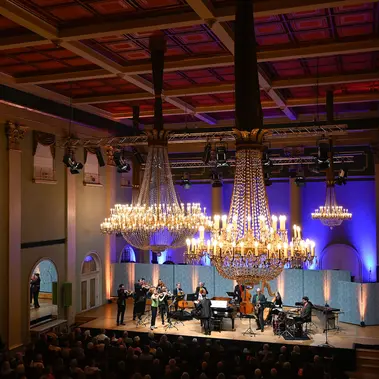Whitsun Festival
Der Rosenkavalier is a waltz opera! It doesn't matter that during the Rococo period the Viennese danced to minuets. Or that the Viennese element in Der Rosenkavalier is an artistic language invented by Hugo von Hofmannsthal – the poet's libretto is already a work of art in itself. And then the music! Contemporary audiences were so enthusiastic that special trains were arranged to take them to the first performances. The opera inaugurates the Whitsun Festival, sung by dream voices down to the smallest role. In this concert-version performance, the SWR Symphonieorchester shines under chief conductor François-Xavier Roth. And after Der Rosenkavalier? Music from the fin de siècle and Rococo eras. In addition, between minuets and waltzes we will be hearing swinging jazz arrangements. Strauss, we’re sure, would be delighted by this rose bouquet.
The Program

SU 17.5.26 & SU 24.5.26
RICHARD STRAUSS - DER ROSENKAVALIER
François-Xavier RothA stellar soloist ensemble shines in our concert-version Rosenkavalier – because Strauss’s opera is a festival of singing! Julia Kleiter is an internationally sought-after soprano, audiences cheered her Marschallin at the Wiener Staatsoper and the Lindenoper Berlin. Canadian mezzo-soprano Emily D’Angelo became the first female singer to win all four major prizes at the Operalia Competition, and her career is now taking off at the Met, in Vienna, Munich, Paris, and Covent Garden. The icing on the cake: Jonathan Tetelman in the brief but feared part of the Italian singer. Singing at its finest!

THU 21.5.26
I BREATHED A GENTLE FRAGRANCE
Songs by Gustav MahlerAt the age of twenty-eight he died in the First World War, and most of his estate was destroyed in a bombing raid in 1945. And so Rudi Stephan's Music for Seven String Instruments is all the more precious: dramatic, tragic, like an expressionist silent film, seeking the grand gesture. Afterwards, we can dream ourselves away from the world – in Mahler's immortal "Ich bin der Welt abhanden gekommen" (I am lost to the world) and other Rückert songs, performed by soloists of the SWR Symphonieorchester.

FR 22.5.26
LATE NIGHT
Libor Šíma & FriendsWhat is an orchestra? In the worst case, it’s like herding cats, in the best case, a goody bag full of hidden geniuses. One such genius is Libor Šíma, principal bassoonist of the SWR Symphonieorchester. In this Late Night, he shows his most colorful side: as a jazz saxophonist, composer, and arranger. With his own compositions and arrangements of international hits, he invites you to join his musical companions for an entertaining evening.

SA 23.5.26
FROM VERSAILLES TO VIENNA
Lully, Mozart & HaydnIt’s as if Joseph Haydn had written a symphony about the Marschallin’s words: Der Rosenkavalier, an opera where a bourgeois family marries into the nobility, continues to resonate in today’s concert program. Following music from the court of the Sun King, we will hear Mozart's last piano concerto. Composed shortly after the outbreak of the French Revolution, its expressive world is already Romantic – and will be presented to us by Kristian Bezuidenhout, a master of historical performance practice.